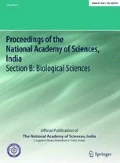Abstract
The lichen diversity in Tawang district of Arunachal Pradesh, India was studied in order to access the long-term effect of climate change in alpine regions of the area. The present study provides an enumeration of 122 species of lichens belonging to 47 genera and 24 families at five major sites of Tawang district of Arunachal Pradesh. Out of 5 sites, Mangalam Gompa (HSP 3), PTSO Lake (HSP 2) and Nagula (HSP 1) are the three highest summit point (HSPs), which have been designated as permanent long-term monitoring sites under the Indian Space Research Organization programme for monitoring the effect of climate change on Himalayan alpine ecosystem while two adjoining additional localities Tawang and SeLa pass were also surveyed. Among 5 localities, the Tawang area has the maximum diversity of lichens represented by 48 species followed by HSP 3 with 41 species and 28 species each in both HSP 2 and HSP 1. The SeLa Pass is represented by occurrence of 26 species only. Lichen family Parmeliaceae is the dominant in the study area, belonging to 51 species followed by Cladoniaceae and Lecanoraceae with 16 and 7 species, respectively. Any alteration in the substratum as well as growth forms of baseline lichen species in near future may help us to predict the habitat shift/composition of species in the area. The biomonitoring procedure could be further standardized and used as part of an environmental monitoring programme in near future.


Similar content being viewed by others
References
McCune B (2000) Lichen communities as indicators of forest health. Bryologist 103:353–356
van Herk CM, Aptroot A, van Dobben HF (2002) Long term monitoring in the Netherland suggests that lichens responds to global warming. Lichenologist 34:141–154
Cameron RP (2002) Habitat associations of epiphytic lichens in managed and unmanaged forest stand in Nova Scotia. North East Nat 9:27–46
Aptroot A (2009) Lichens as an indicator of climate and global change. In: Letcher TM (ed) Climate change: observed impacts on planet Earth. Elsevier, Oxford, p 444
Gauslaa Y (2014) Rain, dew and humid air as drivers of morphology, function and spatial distribution in epiphytic lichens. Lichenologist 46:1–16
Ellis CJ, Coppins BJ, Dawson TP, Seaward MRD (2007) Response of British lichens to climate change scenatios: trends and uncertainties in the projected impact for contrasting biogeographic groups. Biol Cons 140:217–235
Ramstad S, Hestmark G (2001) Population structure and size-dependent reproductive effort in Umbilicaria spodochroa. Mycologia 93(3):453–458
Shukla P, Bajpai R, Singh CP, Sharma N, Upreti DK (2015) Lichen diversity in alpine regions of eastern Sikkim with respect to long term monitoring programme of Indian Space Research Organization. Geophytology 45(1):57–62
Walker FG, James PW (1980) A revised guides to micro chemical techniques for the identification of lichens substances. Bull Brit Lichen Soc 46:13–29
Orange A, James PW, White FJ (2001) Microchemical methods for the identification of lichens. British Lichen Society, London
Awasthi DD (1991) A key to the microlichens of India, Nepal and Sri Lanka. Bibl Lichenol 40:1–337
Awasthi DD (2000) Lichenology in Indian subcontinent. Bishen Singh and Mahendera Pal Singh, Dehradun
Awasthi DD (2007) A compendium of the macrolichens from India, Nepal and Sri Lanka. Bishen Singh and Mahendera Pal Singh, Dehradun
Will-Wolf S, Neitlich P, Esseen PA (2002) Monitoring biodiversity and ecosystem functions: forest. In: Nimis PL, Scheidegger C, Wolseley P (eds) Monitoring with lichens-monitoring lichens NATO science series. Kluwer Academic Publishers, The Hague, pp 203–222
Shukla V, Upreti DK, Bajpai R (2014) Lichen diversity in different lichenogeographical regions of India. In: Shukla V, Upreti DK, Bajpai R (eds) Lichen to biomonitor the environment. Springer, India, pp 61–96
Geiser LH, Neitlich PN (2007) Air pollution and climate gradients in western Oregon and Washington indicated by epiphytic macrolichens. Environ Pollut 145:203–218
Ellis CJ, Coppins BJ (2007) Changing climate and historic woodland structure interact to control species diversity of the Lobarian epiphyte community in Scotland. J Veg Sci 18:725–734
Ellis CJ, Yahr R, Coppins BJ (2009) Local extent of old-growth woodland modifies epiphyte response to climate change. J Biogeog 36:302–313
Peterson EB, Mc Cune B (2003) The importance of hotspots for lichen diversity in forests of western Oregon. Bryologist 106:246–256
Ettinger AK, Ford KR, Lambers JHE (2011) Climate determines upper but not lower altitudinal range limits of Pacific Northwest conifers. Ecology 92:1323–1331
Hennon PE, Amore DVD, Schaberg PG, Wittwer DT, Shanley CS (2012) Shifting climate, altered niche and a dynamic conservation strategy for yellow cedar in the North Pacific Coastal Rainforest. Biol Sci 62:147–158
Root HT, McCune B, Neithlich P (2010) Lichen habitat may be enhanced by thinning treatments in young Tsuga heterophylla–Pseudotsuga menziesii forest. Bryologist 113:292–307
Acknowledgements
The authors would like to thank to Director, CSIR-National Botanical Research Institute Lucknow, India for providing laboratory facilities to work (OLP-083). The authors RB and VS would like to thank to the Department of Science and Technology, New Delhi (DST-SERB) for awarding Young Scientist fellowship (SR/FTP/ES-30/2013) and (SR/FTP/ES-39/2013) respectively. They are also thankful to Space Applications Centre (ISRO) for assistance (GAP 3329).
Author information
Authors and Affiliations
Corresponding author
Ethics declarations
Conflict of interest
The authors declare that they have no conflict of interests.
Rights and permissions
About this article
Cite this article
Bajpai, R., Shukla, V., Singh, C.P. et al. Lichen Community Composition in Tawang District of Arunachal Pradesh, Tool for Long-Term Climate Change Monitoring. Proc. Natl. Acad. Sci., India, Sect. B Biol. Sci. 88, 915–922 (2018). https://doi.org/10.1007/s40011-016-0830-z
Received:
Revised:
Accepted:
Published:
Issue Date:
DOI: https://doi.org/10.1007/s40011-016-0830-z




